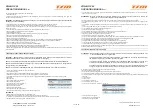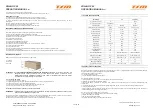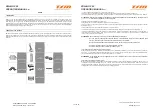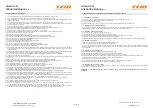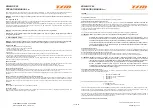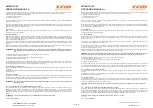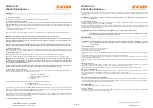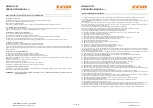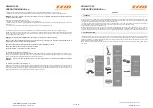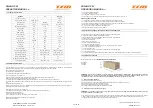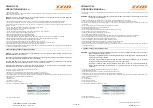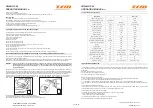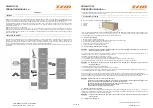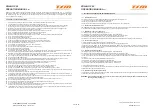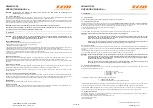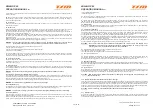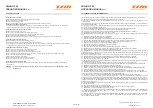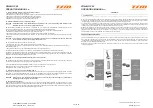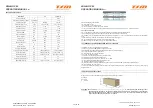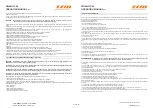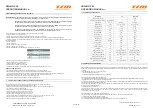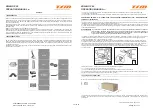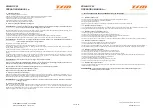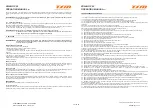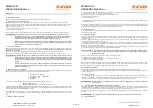
WILLMOP 50
OPERATING MANUAL
V01
9 OPERATION
9.1 Start operations
Perform the operations described in the Opening the packaging chapter (Chapter 7).
9.2 Filling the fresh water tank
Always fill Willmop tank with clean water taken from the tap.
The maximum allowed filling of the tank is 5 liters (1.32 gallons).
The tank can be filled by using the flexible hose located inside the fresh tank (Fig. 7) or by removing the clean water tank from
Willmop and placing it under the tap. To remove the Willmop fresh tank from the chassis you need to:
·
remove the clean water intake hose from the fresh tank (Fig. 8);
·
lifting the sides of the tank up.
To re-insert the Willmop fresh tank on the chassis it is necessary to restore the original condition, explained above.
WARNING - Always fill the tank with clean water, at a temperature not exceeding 50 °C.
Inside the fresh tank it is possible to use detergent in the concentration and in the manner prescribed by the
manufacturer. To avoid the formation of an excessive quantity of foam which would damage the vacuum
motor, use the minimum percentage of detergent.
Always use a low foam detergent. To safely avoid the production of foam, before starting work introduce a
minimum quantity of anti-foaming liquid into the recovery tank. Do not use pure acids.
9.3 The recovery tank
Always make sure you have discharged the dirty water before each new use. Once the dirty water tank is full, turn off Willmop and
empty the tank, where this activity has been arranged.
Never exceed the limit load of 7 liters (1.85 gallons) of dirty water
provided.
To remove the Willmop recovery tank from the chassis it is necessary to lift the sides of the tank up (Fig. 9).
To re-insert the Willmop recovery tank on the chassis it is necessary to replace it in its original position.
WARNING - Willmop is equipped with a system that detects when the recovery tank is full. When the system detects the
full recovery tank, the vacuum motor switchs off automatically and the frontal lights blinks for 5 seconds,
after that the Willmop swtches off completely. It is necessary that the user drains the recovery tank before
continuing with the normal cleaning activity.
When the recovery tank is full, it must be transported in a horizontal position. If the tank when full, was tilted
during transport, it could cause water spill from the bottom of the tank (Fig. 9.1).
9.4 Selecting the operating mode
Willmop's operating mode is chosen on the console by using the program selector knob. Looking frontally at the console, and
going clockwise, the operating modes are:
The following functions can be activated during any operating mode:
If the ENERGY SAVING MODE is switched on, during operating modes 3 and 4, Willmop will save 40% water and 40% suction
power (in operating mode 3), reducing also the noise during use, until the ENERGY SAVING mode button is switched off.
If the ECORAY MODE (available on the only Ecoray version) is switched on, Willmop will use the UV ray system to sanitize the
floor, without the need for more detergent products. The ECORAY MODE will be active until the button is switched off.
9.5 Battery status indicator
The Willmop charge level is indicated in the digital screen located at the top of the battery itself (Fig. 10). The screen is always in
stand-by and to read it, press the button provided.
By pressing the button several times, the information shown are:
·
the remaining battery charge
·
the battery voltage
2
B VACUUM
3
B H2O + VACUUM
4
B H2O
5
BRUSHES
6
ENERGY SAVING MODE
7
ECORAY MODE (available on the only Ecoray version)
WILLMOP 50
OPERATING MANUAL
V01
ACHTUNG - Beachten Sie das Gewicht von Willmop beim Transport und beim Heben, um Verletzungen und
Beschädigungen zu vermeiden.
9.12 Parken von Willmop
Den Lenker in senkrechter Position arretieren (Abb. 1). Stellen Sie sicher, dass Sie die Tanks vollständig entleert haben. Stellen
Sie sicher, dass die Batterie nicht vollständig entladen ist und laden Sie ihn gegebenenfalls auf.
Stellen Sie sich vor Willmop und heben Sie mit einer Hand die Bürsteneinheit leicht an und lassen Sie mit der anderen Hand das
schwenkbare Rad zum Boden los (führen Sie die in Kapitel 9.10 beschriebenen Schritte aus). Auf diese Weise belastet das
Gewicht von Willmop die Bürsten während der Parkphase nicht.
ACHTUNG - Stellen Sie sicher, dass Willmop auf einem glatten Untergrund ohne Gefälle geparkt ist.
Wenn Willmop nicht regelmäßig verwendet wird, lagern Sie den aufgeladenen Batterie an einem trockenen und sauberen
Ort. Stellen Sie sicher, dass die Batterie monatlich aufgeladen wird.
10 WARTUNG
ACHTUNG - Diese Vorgänge müssen bei ausgeschalteter Maschine und ausgeschaltetem Programmwähler in der
Konsole mit Handschuhen ausgeführt werden, um Ihre Hände zu schützen und um sicherzustellen, dass sich
keine Gegenstände oder Personen in der Nähe befinden.
NACH JEDEM GEBRAUCH
·
Entleeren Sie die Tanks und spülen Sie sie mit frischem Wasser aus.
·
Reinigen Sie die Tanks mit einem sauberen, feuchten Tuch.
·
Laden Sie die Batterie bei Bedarf auf.
·
Überprüfen Sie den Verschleiß und die Sauberkeit beider Bürsten. Reinigen Sie die Bürsten mit frischem Wasser (siehe unten).
·
Ersetzen Sie die Bürsten, wenn die weiße Verschleißanzeige die gleiche Höhe wie die anderen Borsten hat.
·
Überprüfen Sie, ob der Saugfuß sauber und intakt ist. Reinigen Sie den Saugfuß mit einem Strahl frischem Wasser und
reinigen Sie ihn mit einem sauberen, feuchten Tuch (wie unten beschrieben).
·
Tauschen Sie die Wischgummis aus, wenn sie vollständig abgenutzt sind, nachdem Sie sie auf beiden Seiten verwendet haben
(wie unten erläutert).
Entfernen Sie die Bürsten
Wenn der Lenker durch das Verriegelungssystem verriegelt bleibt (Abb. 1), muss Willmop gekippt werden, bis der Lenker den
Boden berührt und Willmop vollständig entspannt ist. Ziehen Sie die Bürsten von der Scheibe in Ihre Richtung (Abb. 17).
Überprüfen Sie die Bürstenscheiben visuell und reinigen Sie sie mit einem sauberen, trockenen Tuch, bevor Sie sie wieder
einsetzen.
Entfernen Sie den Saugfuß
Wenn der Lenker durch das Verriegelungssystem verriegelt bleibt (Abb. 1), muss Willmop gekippt werden, bis der Lenker den
Boden berührt und Willmop vollständig entspannt ist. Ziehen Sie den Saugfuß in Ihre Richtung (Abb. 18).
Überprüfen Sie den Saugfuß visuell und reinigen Sie ihn mit einem sauberen, feuchten Tuch, bevor Sie ihn wieder in seiner
Position einsetzen.
Entfernen / ersetzen Sie die Dichtungen des Saugfußes
Lösen Sie nach dem Entfernen der Saugfuß von Willmop die Knöpfe, mit denen die Klingen an dem Saugfuß befestigt sind.
Sobald der Stopper entfernt wurde, kann das vordere Gummiblatt leicht entfernt werden. Wiederholen Sie den Vorgang für beide
Dichtungen des Saugfußes. Um den Saugfuß wieder zusammenzubauen, gehen Sie in umgekehrter Reihenfolge vor.
WÖCHENTLICH
Reinigen Sie Willmop vollständig mit einem sauberen, feuchten Tuch.
Zubehör / Ersatzteile
Verwenden Sie nur von TSM zugelassenes Zubehör und Ersatzteile. Die ausschließliche Verwendung von Originalzubehör und -
ersatzteilen gewährleistet, dass Willmop sicher und problemlos verwendet werden kann.
REINIGUNGSTECHNIK 4 YOU GMBH
Brünnerstraße 192 A, 1210 Wien
25 von 36
+43 1 925 24 81 www.r4you.at

